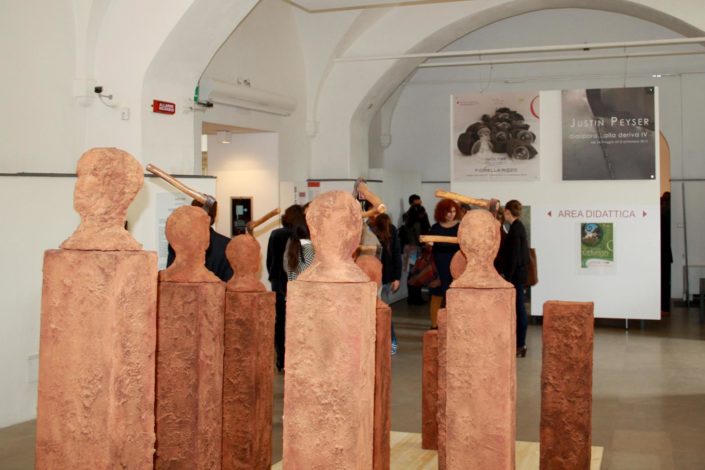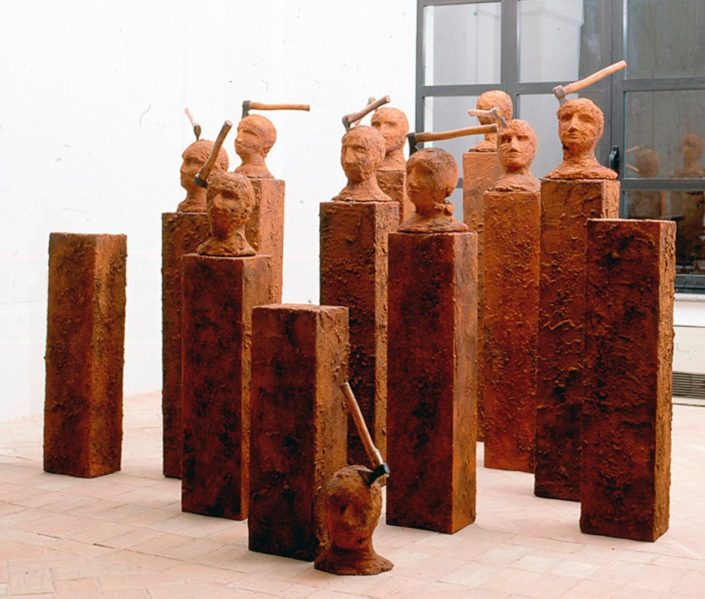FIORELLA RIZZO
INOLTRE
DESCRIPTION
Beyond the Object The poetic reality of Fiorella Rizzo curated by Amnon Barzel.
On Sunday, November 10th, the personal exhibition of Fiorella Rizzo has opened at the Carlo Bilotti Museum, Aranciera di Villa Borghese. The exhibition, curated by Amnon Barzel, is sponsored by the Department of Culture, Creativity and Artistic Promotion – Superintendence of Cultural Heritage of the city of Rome.
“After the visual and sensory deception, gaze travels along the invisible line of imperceptible conjunctions, the creative act is combined with the self-creative process, memory exceeds the bounds of History.” (F. Rizzo, 1993)
This is the artist’s quote that welcomes the visitor in the first room, a key thought to the understanding of InOltre.
The relationship between art and life emerges as very close in this and other writings that Fiorella Rizzo has inserted within the exhibition route.
The exhibition itinerary includes both her main historical works as well as her more recent oeuvres and takes the form of a real journey of discovery of the ego and of its realization through the creative act. This, according to the artist, coincides with the “self-creative” process. Her research integrates deep concepts and ideas to the knowledge of materials and means: land, seeds, glass and plexiglas as well as photographs and videos. Art, life and history are an area without borders for her research.
From the lightness of matter that characterized her first works of the seventies, unified by the common element of the seed, she passes to dense mixtures of red earth. This becomes, in the eighties, the artist’s usual medium, linked to an intense physical and spiritual relationship with her Southern origins.
“Genetliaco” (Birthday) (1981-82), the first installation visible in the exhibition of the Carlo Bilotti Museum (twelve human heads on pedestals made with mixtures of red earth) was considered deeply disturbing to the point that the work will be exhibited for the first time only in 1987, placed in a guarded room of the German Academy in Rome.
On the anticipation of the artist’s work, the curator Amnon Barzel writes: “This exhibition is a significant event in Rome’s contemporary artistic life. Fiorella Rizzo has been working for more than thirty years with important anticipatory results: from the second half of the seventies she tackles the mystery of life with a personal and authentic language, giving form to what is formless”.
In the nineties, she continues her research with everyday materials. These are modified and made unrecognizable either through color or through small structural changes that deceive the eye and emphasize the theme of relativity of perception.
The problem regarding the ambiguity of the look also emerges in her work of photographic origin, all made during her frequent stays in London in the second half of the nineties: images captured by the camera lens just before sinking into the darkness of London’s Underground.
In more recent works, she designed hundreds of bulbs and reported her writings on sheets of acetate, showering them with color and sometimes crumpling and compressing them in plexiglass boxes to form tangles of signs, like fascinating and inextricable paths of knowledge.
“Art, like nature, conceals the mysteries in the visible”, she writes in 1977. For over thirty years Fiorella Rizzo’s work has tended to, as she states, “expand the finite into the infinite, to reveal the infinite in the finite”. In order to do so, the artist worked with something that has neither matter nor weight, crossed the boundless territories of art, life and history, always looking for the most authentic dimension of the ego.
A work by the artist, “Campana” (Bell) (1980), belonging to the permanent collection of the GNAM, Galleria Nazionale d’Arte Moderna in Rome, will be visible to the public in the room 39/40 from Tuesday 15th of October 2013.
STAGES
ITALIA. Roma, Museo Carlo Bilotti, Aranciera di Villa Borghese. November 11th 2013 – January 5th 2014




